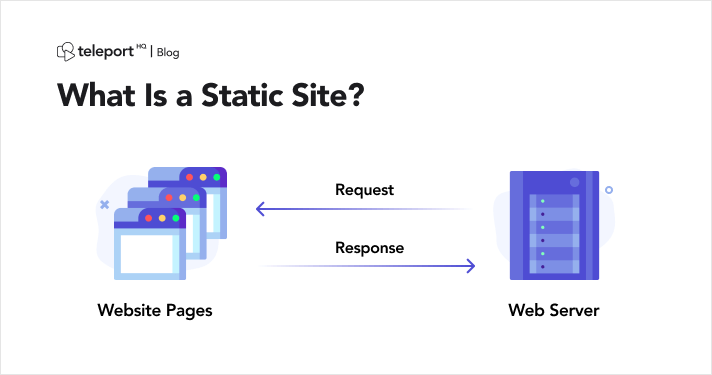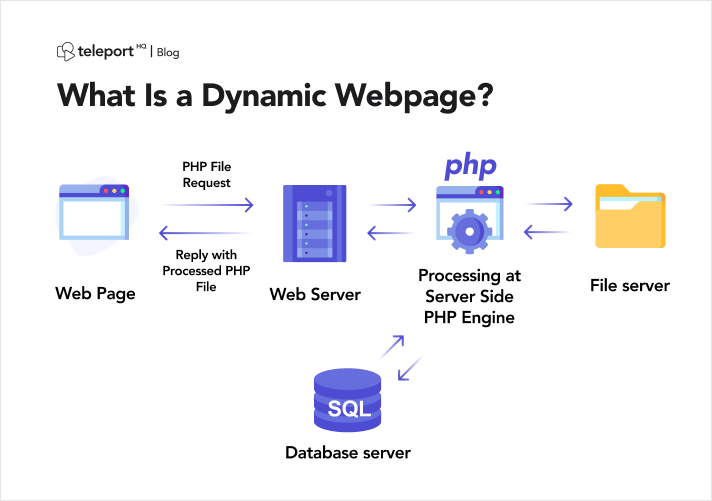People who don't need to create a website don't think too much (or at all) about the difference between a static and a dynamic website. After all, the important thing is that the website is delivered to them in the right way.
The situation is different for those who plan on creating or migrating a website. Knowing the distinctions between static vs. dynamic is essential, and it has much to do with the site's end goal.
Even though these terms may seem difficult right now, by the end of this article you'll master the difference between static and dynamic websites, and you'll be able to make an informed decision regarding your future project.
Start building dynamic websites
Connect your Teleport project with a Headless CMS like Strapi, Contentful, Caisy, Flotiq or Wordpress. Manage the frontend visually with Teleport, using dynamic data from a CMS.
Build your first dynamic websiteIt's important to know that when we say dynamic and static web pages, we refer to how a page is being delivered to the user because, as we'll see later on in the article, static sites can have dynamic components. We also refer to how a website is rendered: either by the server at the time of the request (dynamic) or pre-rendered and delivered via CDN (static).
So, without further ado, let's get right into the subject of static vs. dynamic websites.
A. What Is a Static Website?B. What Is a Dynamic Website?C. Static or dynamic—which one to choose?
A. What Is a Static Website?

As the name suggests, a static website has its content fixed or hard-coded on a page. It also has a defined number of pre-rendered web pages with specific layouts usually cached and delivered via a content delivery network (CDN).
A static website's structure is built using HTML and CSS to add colors and other visual elements without being connected to a database.
This is why its content will appear the same for everyone who accesses it.
But this doesn't mean a static website features only text. You can still add multimedia elements and videos. It's the source page that won't change when a user performs an action on the website.
Now that you know what a static website is, let’s see its strong points, but also the drawbacks.
1. Strong features of a static website
a) Quick to build?
One major difference that weighs in the battle of static website vs. dynamic website is that a static page requires less time to build and deploy due to the simplicity of its software. When it comes to speed there are also static website generators to make things faster.
b) Easy to duplicate
While you have to change the code for the static page whenever you need to deliver a change to your users, you can duplicate the basic code of the static web page, allowing you to make changes to the page while keeping everything steady.
c) Design flexible
Yes, flexibility. Although static in nature, it's also very adaptable. Every static web page from a website can have a different layout and design without being a heavy task for a designer.
d) Cost-effective
Costs are typically lower when building a static website since you don’t have to connect the pages to a database for generating content and rendering the view.
e) More secure
When thinking about static vs. dynamic, you should also consider this important aspect. Static websites have less exposure to the internet than dynamic websites. And since there’s no database that it needs to access, there’s no possibility of making a malicious request. A user can request just the files that contain HTML, CSS, JavaScript, images, audio, or video.
Also, if the server is hacked, fixing the static site is fairly simple. You just need to redeploy the codebase.
f) Fast load times
Because a static web page is pre-rendered, it loads very fast. When a user enters a static page, that page doesn't need to pass through a database, analyzing all the content there. The information is rendered straight from the CDN. Because of its fast load time, it's also easier for a static web page to rank higher for search engines.
2. Drawbacks of a static website
a) Tough to scale
Compared to a dynamic web page, a static one can be more difficult to add to your website over time. For example, if you want to create a static website for your product pages, this means you'll have to add a new product page every time there's a new thing to add.
b) No customization
Because all the static pages are pre-rendered and the same for every user, there’s no possibility for customizing their experience on your website.
c) Difficult to update
Every time you want to update your static pages, you need to change the code of the site.
B. What Is a Dynamic Website?

Compared to static websites, a dynamic website changes based on a user’s request, customizing their experience on the page. These websites rely on both client-side (executed by the browser) and server-side (executed by the server) coding languages such as JavaScript, PHP, or ASP, generating real-time HTML pages with which users can interact.
When a user enters a dynamic website, it changes through the code from the browser and on the server. As in the case of static websites, the result is the same for the users, who will see a page displayed on a web browser, but the dynamic websites process requests and get information from an external database or a content management system (CMS).
So, you know what a dynamic website is, but we should point out its pros and cons too, so you’ll know even better which one to choose between static vs. dynamic website.
1. Strong features of a dynamic website
a) Database or CMS fueled
In the question of static vs. dynamic, you need to know if your website needs to be connected to a database. This will make it easier for your dynamic website to request information that will be delivered to the user depending on what they want to view.
You can also store information about your site visitors in a content management system. The content stored can be text, images, page layouts, and more.
b) Low maintenance cost
If in this dynamic vs. static quest you ever stop to wonder which one is going to be cheaper in the long run, the answer is dynamic websites. This is because the database or CMS will make the necessary changes for you.
c) Better user interaction
Dynamic websites favor functionality and user interaction, with more customization available for each individual.
2. Drawbacks of a dynamic website
a) Design limitations
Since a dynamic website draws its content out of a database, it will display it in a specific way, regardless of the content. Depending on the CMS you're using, creating multiple designs for each type of content delivered can get difficult. This means there's a limitation imposed, and you'll most likely choose a single design approach for everything.
b) Expensive to build
The initial costs of a dynamic website can be high. Additional costs will follow as you will most probably add new features to your dynamic web page.
c) Issues in ranking
A dynamic website gets a heavier load time, which may affect its SEO ranking. Its URL also has to be user-friendly in order to get higher chances of a better search ranking.
d) Caching difficulties
Caching means storing a website's content and then delivering it via a CDN for faster loading times. It's perfect for a static website, but it can become tricky for a dynamic website since its content changes a lot. There can also be security risks connected to caching a user's private information.
C. Static or Dynamic - Which One to Choose?
The most notable difference between a static and a dynamic website is the way the content is delivered. While a static website stays the same until the source code is changed, a dynamic website changes along with users' preferences, locations, and other aspects.
If you’re still debating the problem of static versus dynamic, let us help you with some more information to ease your work.
The most important aspect you need to clarify before choosing between static and dynamic websites is the purpose of your future site.
Here’s why.
A static website is your best option if you need only a few pages meant to deliver information to your audience.
If you need a static website example, think of a landing page about your company or a feature that you want to set apart from the others.
It also works for websites that don't rely on content personalization. Still, if the pages of your website have to look different, you can easily duplicate the HTML code with the necessary changes.
Is a static website a good option for you? If the answer is yes, you can quickly create it with a drag and drop static website builder like TeleportHQ and get it up and running in no time.
On the other hand, dynamic websites are great if you plan to build, let’s say, an ecommerce site that constantly changes according to its visitors.
A dynamic website will help you recommend products to your customers based on their past purchases or remind them about an abandoned shopping cart so that they can complete the purchase.
That being said, a dynamic website example would be Amazon.
Also, because the information supplied to dynamic websites is often restricted due to its sensitivity, they are normally used by private companies and entrepreneurs, and users have to log into a dynamic website for access.
Conclusion
Now that you know what's the difference between static and dynamic, you also know which is the best option for your future website.
In this dynamic vs. static search for answers, the key lies in your expectations of how the site should be.



